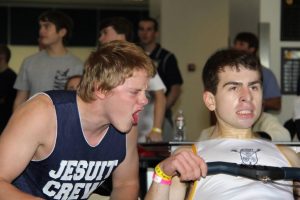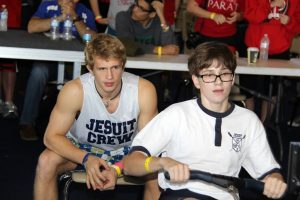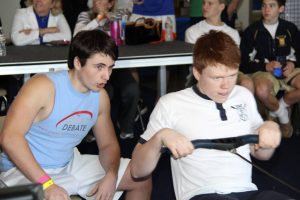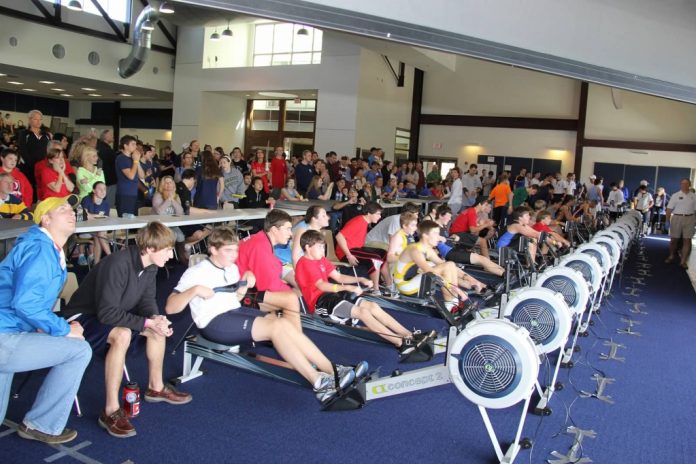 “As soon as you hear that buzzer, all bets are off and all the sound around you fades away. All you can hear is the sound of your own heart beat and heavy breathing, and when that last 500 meters is coming, you start the 40 story plummet straight into hell. I got 1st in my division and I could barely stand after the race. The adrenaline gave me serious tunnel vision and I was slightly deaf. The one thing I remember most clearly is being carried down the stairs to the Erg room and just laying on the floor for a solid 20 minutes.”
“As soon as you hear that buzzer, all bets are off and all the sound around you fades away. All you can hear is the sound of your own heart beat and heavy breathing, and when that last 500 meters is coming, you start the 40 story plummet straight into hell. I got 1st in my division and I could barely stand after the race. The adrenaline gave me serious tunnel vision and I was slightly deaf. The one thing I remember most clearly is being carried down the stairs to the Erg room and just laying on the floor for a solid 20 minutes.”
This quote describes sophomore Jake Gossett’s experience at last year’s Southwest Ergometer Amateur Tournament (SWEAT) Regatta.
 On Saturday, February 2, 2013, the Jesuit Crew team held their annual SWEAT Regatta in the Terry Center. This year it had over 550 rowers including masters, collegiate students, high school students, and even senior citizens. Most of the competitors/teams were from Texas and Oklahoma, yet there were four from Canisius High School in New York. Since 2008, this indoor regatta has experienced immense success, doubling in size.
On Saturday, February 2, 2013, the Jesuit Crew team held their annual SWEAT Regatta in the Terry Center. This year it had over 550 rowers including masters, collegiate students, high school students, and even senior citizens. Most of the competitors/teams were from Texas and Oklahoma, yet there were four from Canisius High School in New York. Since 2008, this indoor regatta has experienced immense success, doubling in size.
Rowers compete indoors on machines called ergometers. The “erg” is an attempt to replicate the experience of rowing on the water on an exercise machine and thus follows a similar concept in how it works. The pattern of movement is nearly identical, using your legs to launch yourself from the feet straps and then following through with the backs and the arms, which hold onto the handle, and going back up the slide in the reverse order. Fifteen ergs were used for each heat, but Jesuit owns about thirty in total. The machines, which cost about $900, have a screen in the front displaying time, distance, and speed split per 500 meters (time/500 meters). Each erg is hooked up to a computer that displays each rower’s position on a projector.
 Mitchell Opatowsky ’15 described the 2000 meter race as “pretty much an all out explosion of energy for 7 minutes . . . however sounding easy, there is nothing more of the opposite than easy than a 2 kilometer race, yet the feeling afterwards is so rewarding that it makes it all worth it because, at least if you did well and made a personal record of a good degree lower than your previous score . . . you will have one of greatest senses of satisfaction that you could ever feel. Just knowing that you’re done and that you accomplished such an impressive feat is inspiring and motivating. Even though 2 kilometers is nothing in distance compared to a “big easy” 40 minutes, 30, and then 20 at a rather steady pace and tempo is a test of endurance and commitment.”
Mitchell Opatowsky ’15 described the 2000 meter race as “pretty much an all out explosion of energy for 7 minutes . . . however sounding easy, there is nothing more of the opposite than easy than a 2 kilometer race, yet the feeling afterwards is so rewarding that it makes it all worth it because, at least if you did well and made a personal record of a good degree lower than your previous score . . . you will have one of greatest senses of satisfaction that you could ever feel. Just knowing that you’re done and that you accomplished such an impressive feat is inspiring and motivating. Even though 2 kilometers is nothing in distance compared to a “big easy” 40 minutes, 30, and then 20 at a rather steady pace and tempo is a test of endurance and commitment.”
Individuals earn points which add up to make their teams’ total scores. The men’s total points came from freshmen, JV, and Varsity. This year, Jesuit finished in second place for the men’s cup behind Austin Rowing Club.
Mitch McHugh ’14 stated that “even with a second place finish, I think the team preformed to the best of our abilities. Each rower did an incredible job and the hard work of winter training really showed.”
Similarly, Connor Kerl ’15 said that “we would have liked to win, but we improved as a team.”
 The competition was not boys-only. Girls had their own races and cup, and the Ursuline rowers were among those competing for the women’s cup.
The competition was not boys-only. Girls had their own races and cup, and the Ursuline rowers were among those competing for the women’s cup.
By the end of the day, there were many Jesuit medalists. Among them was Adam Hyman ’15 who won the freshmen division, as well as Alex Cohen ’13 who won in the junior lightweight division.
The Jesuit Crew team will continue to put in hard work and long practice hours to try to continue their success this year.
Sam Todora ’15 summed up the event, saying that “when you get on the erg, nothing else matters, but how low your erg score is . . . this year . . . there were more people than ever, it was run smoother than ever, and I think that made the experience more enjoyable for all participants and spectators of the event and hopefully next year will be even better.”






